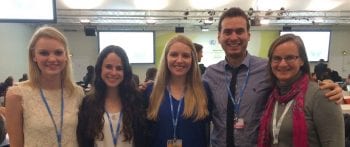
Gephardt Institute Community Engagement Faculty Fellow Beth Martin discusses her efforts to support community engaged teaching on campus.
How would you describe your work as a community engaged instructor?
What I try to do through my teaching is help students be aware of how what they learn in the classroom has life outside the classroom. Through my work at Gephardt, we are determining what questions need to be asked and what support faculty may need or want in terms of beginning or increasing the amount of community engaged work they do.
What courses do you teach right now, and what have you taught in the past?
I teach a freshman seminar called “A Sense of Place: Exploring the Environment of St. Louis.” I also take a group of students to the International Climate Negotiations each year to see the intersection of science and policy on the international stage.
If you think of the community engaged teaching spectrum, these are on one end of the spectrum in the sense that the focus for the students is on awareness and observation. Students are not producing a product, there’s not a specific community partner in place, but we get out of the classroom and meet with professionals in the field, and they get to see with their eyes what they’ve been reading about in class.
I taught in the Interdisciplinary Environmental Clinic in the law school for fourteen years, where we did pro bono work on behalf of environmental organizations. So if my undergraduate courses are on one end of the spectrum, the clinic is on the other end of the spectrum, where the students are producing a professional work product on behalf of clients that is being put out into the public space. And all of these are examples of Community Engaged Teaching.
Can you tell me about your work with the Baden community in North St. Louis?
I’m working with the Sustainability Exchange, an interdisciplinary course taught by Professor Bill Lowry and supported by Professor Bruce Lindsey and several other faculty that lead the student projects. In the Exchange, students work on projects presented by faculty, many of which have a community-based component. Our project centers on the community of Baden in North St. Louis. When the sewer system in St. Louis was developed streams were turned into sewers. Baden is experiencing remnant water problems that lead to overland flooding and basement backups. The long term challenge is to reimagine green space development that will handle storm water and be an amenity to the community. Professor Rod Barnett in Landscape Architecture is working with students this semester in studio and exploring what that design might look like. The students on my team are working to compile environmental data on soils and plants that was previously collected into a report that can be used by researchers and designers moving forward.
What is the impact of Community Engaged Teaching on students?
At the end of the day I hope that they learn more and don’t forget what they learned. When students can see how what they’re learning in a class has implications in the outside world, whether it’s simply from observation, writing a letter, or digging into a case, it is empowering for the students.
What would you tell fellow faculty members to encourage them to consider a community engaged component in their teaching?
There’s often a learning phase that needs to come first. In conversation with many faculty and departments, often in the science and engineering fields, I’ve noticed that there’s often the claim that ‘we don’t do Community Engaged Teaching’ and we have a conversation and then we realize ‘yes, you do!’ So we’re getting a sense of what the current picture looks like. We’ve also spent a lot of time bringing faculty together to share ideas and best practices and look forward to continuing that work next year.
For you personally, how has it changed your teaching, and what makes you want to do this type of work?
You’re going to get a different answer depending on the person. For me, it really is about the learning experience for students. They see, in a safe space, what some of the practical challenges will be when they leave WashU. That’s what I enjoy and how I like to teach. But that also connects with an awareness the students have of the impact they can have on the community. If we as an institution want this to be a learning experience for our students, it has to also be a beneficial experience for those in the community. If students can do something that helps someone, rather than produce something that sits on a bookshelf, why not?
Learn more about Community Engaged Teaching and Learning at WashU, and find ways to become involved.